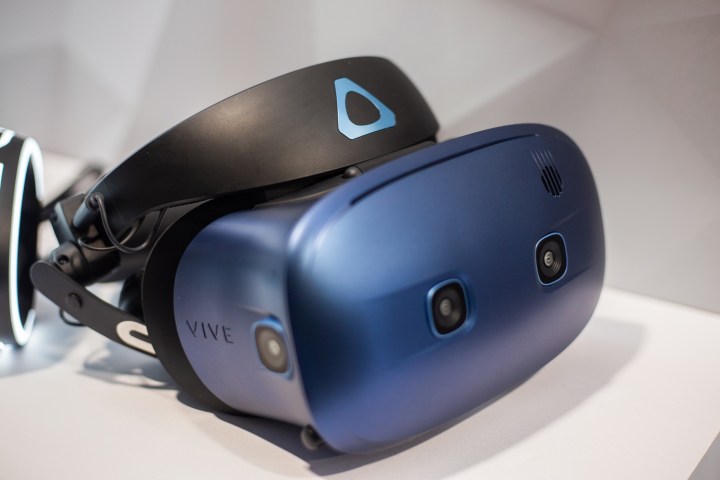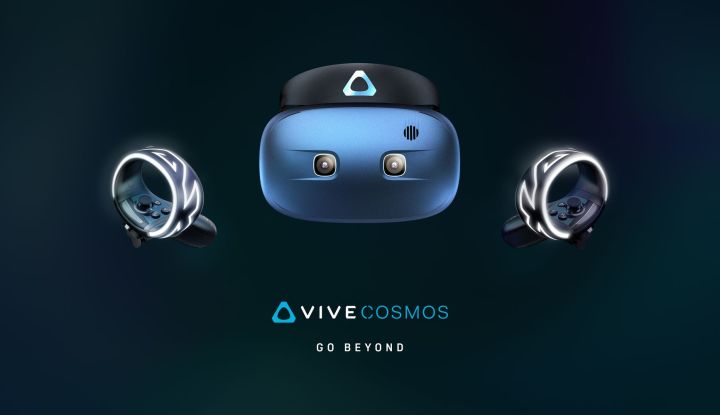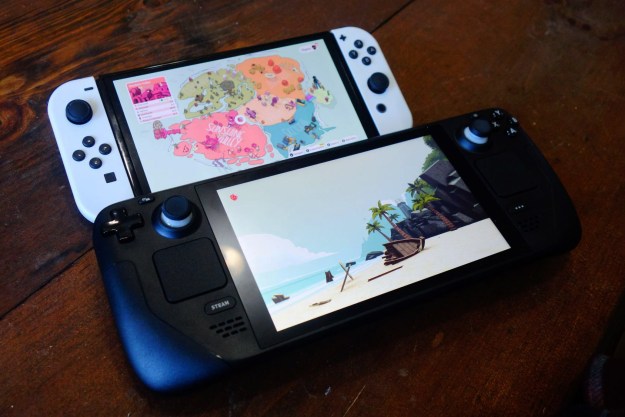Alongside price and potential motion sickness, ease of use stands as one of the biggest barriers for virtual reality. The difficulty of setting up a VR headset can be more trouble than the experiences themselves are worth, and when companies have addressed this issue head-on, they’ve seen success.
We’ve already seen this with the mass-audience-focused Oculus Quest and upgraded Rift S, and HTC Vive aims to bring this ease of use to the premium market with Vive Cosmos. HTC finally revealed more details about its upcoming VR headset and how it aims to bring the same high-quality PC virtual reality experience to players, but without the hassle associated with traditional VR setups. Here’s everything we know about it so far.
Hardware and design

The Vive Cosmos is not a stand-alone or wireless headset like the Oculus Quest, but rather a PC-compatible virtual reality headset that is designed to be portable and easy to use. It features just a single cable coming from the left side of the headset and uses cameras located on the headset itself instead of separate tracking cameras.
The Vive Cosmos will have four cameras by default, with one on either side and two on the front, as well as an additional two that can be added via a removable faceplate. The faceplate cameras are located on the top and bottom, with the latter likely better at tracking your hand motions. Though removable, this accessory will come packaged with the headset.
These cameras are used to track all of your movements, and the self-contained design should make it possible to use the Vive Cosmos in a greater variety of play areas. There are also speakers located on either side, negating the need for traditional headphones commonly used with other VR headsets. If you want to use your own headphones, instead, it appears there will still be a traditional 3.5mm input. The speakers that come attached by default are removable.
The tracking technology uses “six-degrees-of-freedom” and gesture-tracking support, making it more intuitive than past VR headsets. With breathable materials and a lighter design, it should also be more comfortable than other headsets you’ve used, and it’s designed to quickly dry if you happen to work up a sweat during a play session. The front of the headset is also vented, which should assist in keeping you from working up too much of a sweat in the first place.
Simply taking off a VR headset can be a hassle, as you typically have to remove the band around the back of your head and lift the entire device upward. With the Vive Cosmos, you will be able to flip the front lens component upward without adjusting the band, allowing you to move in the real world before reentering virtual reality.
Thus far, HTC Vive has only confirmed that the Vive Cosmos will be compatible with PC systems. However, during the official unveiling back at CES 2019 in January, an image of a mobile phone was shown on screen. It’s unclear if phones will be supported at launch, but it will eventually be “powered by more than a traditional gaming PC.”
Improvements

The Vive Cosmos isn’t designed to be a closed-platform headset. Instead, over time you will be able to modify it with what HTC Vive calls “an ever-increasing suite” of possibilities. The faceplate mentioned earlier is likely the first of these mods.
HTC Vive isn’t yet willing to talk about the extent of other modifications, or what they will do for the Vive Cosmos. Eye-tracking technology is available on the Vive Pro Eye. When asked by UploadVR if an add-on could allow Cosmos users to utilize this technology as well, Vive GM Daniel O’Brien simply said there was “a lot more to come” regarding its modular nature.
Compared to its past headsets, HTC Vive said that the Vive Cosmos will feature its “sharpest screens yet,” and will use RGB displays with “minimal screen-door effect.” This effect is common on cheaper headsets, including the PlayStation VR, and exists to some degree on most VR displays.
The resolution on the Vive Cosmos will be 2880 x 1700, which is nearly double the resolution of the original Vive, and it will reportedly have 40% higher lens clarity than the original system. The Vive Cosmos will be capable of framerates of up to 90 frames per second.
New Vive Cosmos controllers

The Vive Cosmos’ innovations aren’t only in the headset itself, but also in the controllers it comes bundled with. The heavily-illuminated controllers are designed to track every single move you make in conjunction with the cameras on the headset. The design for this is a sort of lightning bolt shape, presumably to be better recognized by the cameras in a variety of scenarios.
The buttons themselves resemble what we’ve seen in past touch-style VR controllers, but have been given an ergonomic overhaul, and they’re fully compatible with older VR titles. The thumbsticks closely resemble the Xbox One’s controller, with an indentation to better hold your thumb in place.
Shoulder buttons and triggers are located on top of each Vive Cosmos controller, and they’re equipped with wrist straps so you don’t send one flying through your monitor during a virtual boxing match.
Vive Reality System
The Vive Cosmos will be the first device to make use of HTC’s Creative Labs’ Vive Reality System. Designed as a replacement for traditional menu screens, Vive Reality System will usher you between virtual worlds from the moment you turn the Vive Cosmos on. Initially, you will load into an environment called “Origin,” which acts as your station to access other experiences. When you load into it, you will see different content each time, including changing artwork. It will also act as a social hub for interacting with friends before you decide on a game to play.
“We want VR to feel less like launching apps and instead like stepping into worlds,” Creative Labs VP Drew Bamford said back at CES 2019.
In keeping with that philosophy, the Vive Reality System also includes a feature called “Lens.” Acting as a sort of quick menu, Lens allows you to quickly view the time or battery life, and launch a separate app without having to go through a traditional menu. Mozilla will have a VR browser available for Vive Reality System, with some pages designed specifically for VR users alongside traditional web pages.
Games
Unlike the Oculus Quest, which has its own library of compatible games, the Vive Cosmos will be compatible with the games you purchased on Steam. This means that if it’s your second Steam-compatible headset, you shouldn’t have to purchase additional titles in order to use it. It will be compatible with OpenVR and SteamVR, though using these will likely mean you won’t be accessing the new Vive Reality System interface.
The Vive Cosmos will also be compatible with the Viveport Infinity subscription service, which is currently available on several other headsets. There are more than 500 titles available in the vault, and you can play them as much as you want, provided that you maintain your membership. Games included range from AAA blockbuster experiences to shorter indie titles. A subscription currently costs $13 per month.
Release date and price

HTC Vive has not nailed down a final release date for the Vive Cosmos yet, but the team is currently targeting a Q3 2019 window. HTC Vive has previously revealed that developer kits would ship in early 2019 and that apparently meant June, as they are now being sent out to developers.
A final price point has also not been made public yet, but it will likely be under $900. Given that the Rift S costs less than half of this, as does the Oculus Quest, we’re hoping it will be well below this. Speaking to Road to VR, an HTC Vive spokesperson said that it would deliver “great value” in the final product, without giving an estimate on what the headset would cost.
In a separate interview with UploadVR, Vive GM Daniel O’Brien stressed the headset’s “scalability” and use for different types of customers. This was likely a reference to its use with both phones and PCs, but it could also mean the price is positioned between those types of headsets as well.
Editors' Recommendations
- Among Us VR, Ghostbusters, and more coming to Meta Quest 2
- The most common HTC Vive problems, and how to fix them
- HTC Vive Cosmos vs. Vive Pro
- Nvidia GeForce Now: Price, beta, features, and more


